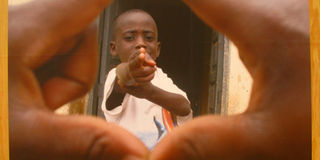Art exhibition tells Africa story in Kampala

One of the photographs at the exhibition. PHOTO BY JUDE KATENDE
What you need to know:
Many African countries are celebrating 50 years of independence
If we are to go by the saying that a picture speaks a thousand words, it would be undisputable to say the ongoing Visionary for Art: Art at Work exhibition opposite the Kampala Railway Station is worth more than that. Held for the first time in Kampala, this exhibition is presented in several African cities.
After a launch in Tripoli Libya, at the 2010 EU-African Union Summit, it was presented in Ouagadougou (Burkina Faso, 2011) during one of the focal points of celebration of African culture, the pan-African cinema and television festival (FESPACO).
It was then held in Addis Ababa (Ethiopia) at the headquarters of the African Union on the occasion of the African Union Summit (January 2012), in the ‘green lung’ of Cairo (Egypt), Park AL AZHAR (February 2012), in the National Gallery of Zimbabwe in Harare (Zimbabwe) during Africa Week (May 2012), and in Bujumbura (Burundi) at the Palace of Sports and Culture (July 2012).
Visionary Africa – Art at Work is an itinerant urban exhibition of contemporary African artistic practices organised jointly by the European Commission and the Palais des Beaux-Arts (Centre for Fine Arts) in Brussels, including artist residencies, showcases of local artists, and workshops on art and development in modern urban centres in Africa.
As several African countries celebrate their 50th independence anniversary, the exhibition’s intent is to focus on the importance of culture and creativity as a motor for development. The aim is to further provide, through the work of artists, a snapshot of transformations that have occurred on the African continent during the last half century, as well as put its future development into perspective. Ghanaian architect David Adjaye designed the exhibition pavilion housing several African photographers’ works.
It is free to the public. All works exhibited are reproductions. Arts and Culture met many curious visitors, some wondering what it was all about and others liking the idea of the photos showcased.
Marleen, a researcher who only gave her first name said: “I like the idea of bringing art out of the galleries to the streets and ghettos.” She was particularly interested in the Bavubuka Foundation Katanga Project photos of Daniel Gilbert Bwette. Misaki Okiror summarised the show in two words, “extremely lovely.”
Comparing cities
Henry Wasake, a trader, was a little curious but later understood after an explanation was given. He said he found African cities interesting and went about comparing them with Kampala. “Kigali and Bujumbura are still doing badly, they are yet to equal us. The North African cities are however ahead of us,” he told Arts and Culture.
Besides notable celebrated photographers such as Mohammed Mo Amin, who photographed President Idi Amin swearing in, there are quite a number of good Ugandan works. There is Pan-African photography, “A Useful Dream”, celebrating 50 years of African photography, curated by Simon Njami. In this section, photographs are about the dream of achieving independence by Africans.
“Urban Africa”, is a decade-long personal survey by David Adjaye on the architecture of African capitals. Traces and Routes, is a showcase of Ugandan photographic archives and contemporary photographs co-curated by Katrin Peters-Klaphake, curator of the Makerere Art Gallery/IHCR, and Margaret Nagawa, anindependent curator.
Nelson Mandela boxing, night club scenes and Drum Magazine covers are some of the captivating shots.
The project proposes an artist residency for an African artist from another region. Freddy Tsimba, sculptor from DRC, will spend three weeks in Kampala, working on a new project inspired by the city and its artists.




